Diesel shunters at Bescot - a brief history
Early 1950s: the first diesels arrive
The first diesel shunters arrived in the West Midlands in 1947, prior to nationalisation. These were four LMS designed D3/8
locos7126 7127 7128 7129
(later 12039 12040 12041 12042) allocated to Saltley and used at Washwood Heath.
Bescot didn't gain an allocation until the second half of 1951. These were also D3/8s, later designated Class 11 by British
Railways. Although the earliest Class 11s were built by the LMS in 1945 the first ones allocated to Bescot were BR-built locos, new in 1951. In
later years a number of LMS-built Class D3/7 shunters with jackshaft transmission migrated to Bescot, the earliest of which dated from 1939.
However it would be nearly a decade before those arrived.
Summer 1951 saw a trio of Class 11s allocated to Bescot, specifically 12090, 12091 and 12092. These were part of a batch of eight diesel shunters allocated to the LMR's Western District in the second half of that year, the others going to Bushbury12093 12094 and Aston12088 12089 12095. 12090 was re-allocated to Aston after only a couple of months, but the other two remained throughout the 1950s. In practise it seems that despite their depot allocations these eight locos operated as a single pool with maintenance being undertaken at Aston. The initial duties at Bescot were as the three hump pilots.
12091 is of particular interest. Its first allocation after being built at Derby Works was to Bescot in July 1951. However a month later it was re-allocated to Mexborough. This was a relatively unusual move, as Eastern Region depots only got the later Class 11s built at Darlington from 1952 onwards. The trip to Mexborough was evidently for trials, probably in Wath Yard. Evidently 12091 went straight to the ER when outshopped from Derby, and its brief summer 1951 allocation to Bescot was a paper transfer only. It returned to Bescot in October 1951.
The rest of the 1950s saw little change, with just these Class 11s on the books.
Early 1960s: the fleet size starts to increase
After the stability of the 1950s the diesel shunter fleet slowly started to increase in number during the 1960s. November 1960 saw four D3/7 (jackshaft)12004 12012 12013 12030 locos arrive. They were the only locos of this type ever allocated to Bescot, and all had gone by early 1966. Two of the jackshaft locos came from Crewe12013 12030 and two from Monument Lane12004 12012. The latter two were part of a swap, with a Class 08D3841 and a Class 1112092 going the other way. The Class 08 was significant. It came from Carnforth, and stayed for less than a month during late 1960 before moving on to Monument Lane. It may only have been a paper transfer in practise, but either way D3841 was the first of its type officially allocated to Bescot. It would return in April 1967, get renumbered to 08674 in 1974, and remain at Bescot until it was withdrawn in the summer of 1981.
1961 saw a single Class 1112095 arrive, and in 1962 another two12056 12087 followed. During the second half of 1964 one of the D3/7s12030 was withdrawn and another left12012, as did a couple of the Class 11s12091 12095. In their place came a quartet of Class 08sD3088 D3115 D3116 D3871, the first significant arrival of what would soon become the mainstay of the Bescot diesel shunter fleet. 1965 saw three incoming Class 11s12077 12091 12093, and another two Class 08sD3090 D3867 arrive. Most of the 1965 arrivals came from Bushbury, which closed in April of that year. One of these ex-Bushbury locos was D3867, which like D3841 was destined to become a long-stay resident. It would become 08700, and remain at Bescot for around twenty-five years. It survives to this day in preservation at the East Lancs Railway.
In early 1966 the penultimate D3/7 left12013, and another two Class 08sD3111 D3112 arrived. These were the last arrivals before Bescot lost its complete diesel shunter fleet in April 1966. At that point Bescot steam shed closed, although 47 years would elapse before it was demolished. As a consequence Bescot's allocation of diesel shunters was temporarily transferred to Ryecroft, pending the building of the new diesel depot. At that point the allocation was as follows...
| Locos transferred from Bescot to Ryecroft in April 1966 | |
|---|---|
| Class D3/7 | 12004 |
| Class 08 | D3088 D3090 D3111 D3112 D3115 D3116 D3867 |
| Class 11 | 12056 12077 12087 12091 12093 |
| Total number of locos: 13 | |
The late 1960s: steam shed closures and the new diesel depot
By the mid-60s a number of neighbouring West Midlands sheds had also acquired an allocation of diesel shunters. Like Bescot, these were steam sheds, but unlike Bescot when they closed no diesel depot was built to replace them. As a consequence Bescot inherited both the shunt loco allocations, and the shunt duties, of these closed sheds.
So for a year or so Bescot had no allocation, although there would still have been diesel shunters working the yards of course. The new diesel depot opened in the spring of 1967. At that point Bescot not only regained most of its previous shunters from Ryecroft, but it also acquired the complete allocations of several neighbouring sheds. The table below shows the incoming allocation in early 1967, co-inciding with the opening of the diesel depot.
| From | Locos transferred to Bescot in April 1967 | Total |
|---|---|---|
| Monument Lane |
Class 03:D2386 D2387 D2395 (all 01/67 to Tyseley, then 03/67 to Bescot) Class 08:D3034 D3089 D3839 D3840 D3841 Class 11:12071 12092 (all 04/67) |
10 |
| Stourbridge Jct | Class 08:D3025 D3029 D3192 D3980 D3981 D3982 D3995 D3996 D3997 Class 11:12094 Class D3/11:15101 15102 15103 15104 | 14 |
| Oxley | Class 03:D2396 (03/67) Class 04:D2220 (03/67) Class 08:D3027 D3036 D3037 D3038 D3039 D3191 D3752 D3755 D3757 D3871 D3977 D3978 D3979 | 15 |
| Ryecroft | Class 08:D3021 D3088 D3090 D3091 D3111 D3112 D3115 D3116 D3780 D3781 D3867 Class 11:12056 12087 Class D3/11:15105 15106 | 15 |
| Total number of locos allocated: 54 | ||
Of some note in the list above are a handful of diesel-mechanical locos, specifically four Class 03s and a Class 04, plus the full set of six D3/11 locos of GWR origin. As a result 1967 was not just the point at which Bescot's shunt loco allocation was at its greatest, but also when it was at its most diverse. In the summer of that year the fleet included examples of Class 03, 04, 08, 11 plus the D3/11s. However this variety was very much an aberration, and it proved to be very short-lived.
Until the mid-60s most of the allocation changes would have been precipitated by the transition from steam to diesel, the increased requirement for diesels generated by that process exceeding any reduction in shunt duties resulting from loss of traffic. But by the time the diesel depot opened the last of the steam had gone, and subsequent changes would be entirely down to traffic requirements or operational re-organisations. This almost always meant a reduction in the demand for diesel shunters, and it started almost immediately with significant clearouts during 1967 and 1968.
The first casualties were the six D3/11s, which were all withdrawn in the summer of 1967. The five diesel-mechanicals had gone by April 1968, and most of the Class 11s wouldn't be far behind them.
Although the summer of 1967 saw the withdrawal of the D3/11s, their loss was mitigated by the arrival of couple of Class 08sD3023 D3024 and two Class 11s12065 12112. But overall the year saw thirteen departuresD2396 12092 12094 15101 15102 15103 15104 15105 15106 D3027 D3039 D3996 D3997 and a net loss of nine locos, taking the allocation down to forty-five.
The losses in 1968 were even greater. As well as the diesel-mechanicals and a couple of Class 11s12065 12112 no fewer than ten Class 08s in the D30xx numberD3021 D3023 D3024 D3025 D3029 D3034 D3036 D3037 D3038 D3089 series left during the summer. In all 1968 saw sixteen departures and only two arrivalsD3364 D3397, a net loss of fourteen locos which reduced the fleet to thirty-one. In effect just over 40% of the fleet inherited in April 1967 had gone by the end of 1968.
Things had started to settle down by 1969, but time was nearly up for the Class 11s. There were only three departuresD3112 D3192 12071, and they were balanced by three arrivalsD3106 D3108 D3538. However the loss of 12071 in early 1969 left only two Class 11s on the books. The last pair, 12056 and 12087 finished their lives working as the up and down hump pilots. They lasted into the second half of 1971 before being replaced by Class 08s (specifically 08294 and 08327 for much of the 1970s). From late 1971 Bescot's shunt loco allocation consisted solely of Class 08s, a state of affairs that persisted for well over twenty years until the first Class 09 arrived.
| Bescot's shunt loco allocation in December 1969 | |
|---|---|
| Class 08 | D3088 D3090 D3091 D3106 D3108 D3111 D3115 D3116 D3191 D3364 D3397 D3538 D3752 D3755 D3757 D3780 D3781 D3839 D3840 D3841 D3867 D3871 D3977 D3978 D3979 D3980 D3981 D3982 D3995 |
| Class 11 | 12056 12087 |
| Total number of locos: 31 | |
The 1970s: a decade of relative stability
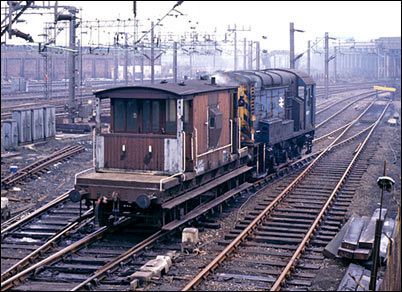
Once the dust had settled on the major changes of the late 1960s there was a decade or so of relative stability. There was inevitable decline during the 1970s, some goods facilities closed, and elsewhere a few shunting duties were taken over by mainline locos on the related trip workings. But these losses were relatively modest in number and many duties remained. For example there were twenty-five duties in 1971, but this had only reduced to nineteen as late as winter 1978.
The 1970s losses included the Rood End No 2 job, which had gone by 1972. The Soho Pool and Oldbury duties were amalgamated into one job around the same time, reducing the loco requirement by another one. This was followed by the remaining Rood End duty which had gone by May 1976. A re-jigged T52, booked for a Class 25, then covered both the Langley Green trips and remaining shunt duties. The Oldbury job, still shown as shunting Soho Pool, Albion Gulf and Spon Lane Basin in October 1975, had also gone by May 1976. In this case there's no sign of any trips to these places in the May 76 notice. Taken together these changes reduced the number of duties by four.
A further mid-70s casualty was the Norton Jn job, which took the losses in this period up to five. The steady reduction in traffic also saw the abolition of the afternoon shifts on three Bescot yard duties by May 1976. These were T01 (Up Hump), T04 (Up Yard) and T08 (Down Local). However there were still duties for six pilots in the yard, so this had no effect on the overall requirement for shunt locos and as a result these changes weren't particularly visible.
| Bescot's shunt loco allocation in December 1979 |
|---|
| 08019 08083 08177 08294 08327 08466 08474 08585 08588 08590 08613 08614 08672 08673 08674 08700 08703 08765 08783 08788 08809 08832 08841 08901 |
| Total number of locos: 24 |
Locos with skirts
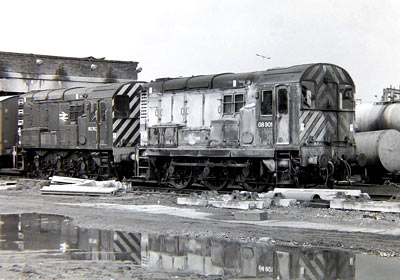
In 1971 Bescot acquired D4131, and the following year D3933 arrived. These would later become 08901 and 08765 respectively, and they were the first of four shunt locos which were fitted with rubber "skirts" while at Bescot to help prevent water ingress when taking coaching stock through the washing plant at Oxley. The other two locos were 08841, which arrived in 1975, and 08832 which didn't appear until 1979.
Over time all four locos would exhibit the faded paintwork which affected any shunters that regularly worked carriage washer duties. But to the best of my knowledge only the Bescot foursome were fitted with the skirts.
From the early 1970s right through until the 1990s the Oxley pilot duty was invariably covered by one of these locos, and a second one would often be found in the Wolverhampton area. The others might be at Bescot for maintenance, or out working other turns.
1979 to 1983: four years of carnage
After a decade of slow decline the three-year period from 1979 to 1982 saw the closure of the three Black Country steelworks at Round Oak, Bilston and Wednesbury. The effect on rail traffic around Bescot was catastrophic, and a significant number of shunting duties were lost as a direct result. On top of this British Rail closed its parcels operation during the same period, resulting in the loss of even more shunting jobs at Wolverhampton.
The first of the steelworks to go was Bilston, which closed in April 1979. The Spring Vale shunting duty survived into 1980, albeit down to a single daytime shift by May of that year. It had gone by October 1980.
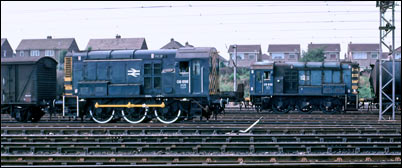
The Round Oak duty had already been reduced to a single daytime shift by May 1979. It ran up there each day from Stourbridge Jct. By October 1979 the duty had gone completely. The steelworks didn't finally close until December 1982, but had been running down in the preceding years.
The Patent Shaft steelworks in Wednesbury closed in June 1980. The Wednesbury No 2 duty (T51) was still a two-shift job in October of that year, but had gone completely by the summer of 1981.
An indirect consequence of the demise of the steelworks was the closure of the Up Reception Sidings at Bescot, with the resulting loss of two shunt duties. The Up Hump (T01) and Up Yard South End (T02) jobs were both abolished on 3rd August 1981, bringing the number of yard duties down to four. At the same time the Down Local pilot (T06) was amended to cover the South End shunt in the afternoons. The upshot of all this was a loss of five shunt duties, three at the steelworks and two at Bescot. There were, of course, significant reductions in the number of local trip workings as well.
October 1979 saw the Wednesfield Rd (T45) and Wolverhampton High Level (T46) shunt duties now covered by the same loco. T45 was a daytime job, and T46 a night-time one. The duties retained their separate trip numbers, however this change reduced the number of shunt locos required by one. Then from 1st June 1981 both the Wolverhampton High Level (T46) and Low Level (T50) jobs were abolished - victims of the closure of the parcels business. The Wednesfield Road duty (T45) survived so the shunt loco requirement only diminished by one at this point. But taken together these changes reduced the loco requirement by two, in addition to the five losses attributable to the steelworks closures.
Other losses in the same period included Walsall Goods, which was abolished on 3rd August 1981, the same day as the Bescot Yard duties went. The Brierley Hill job was still a two-shift affair in June 1981, mornings and evenings, but it had gone by May 1982. The yard survived, and Stourbridge's T57 - booked for a Class 25 - covered Brierley Hill and Pensnett, presumably taking on the residual shunting duties. This reduced the number of shunt locos by a further two - taking the total number of losses in this period up to nine.
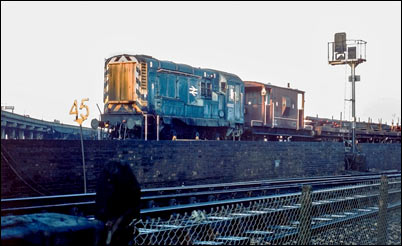
Finally, May 1983 saw a recast of the trip numbers, and yet more losses. Both the Kidderminster and Wellington jobs were abolished, as was the Bescot Down Local duty. This reduced the number of pilots in Bescot Yard to three, and increased the number of losses in the period to twelve.
Rather against the trend a new duty appeared in May 1983, a second pilot job at Oxley CS. However the new job was a night-time duty (T24), and was covered by the same loco which worked the Wednesfield Road duty (by then T05) during the day. As a consequence the new duty didn't require an additional loco. In the event the Wednesfield Road duty was abolished on 11th July 1983, however the loco would still be needed for the overnight Oxley job so there was no reduction in the loco requirement as a consequence.
Also new in September 1983 was a T96 job based in Bescot Up Yard, but including engineer's trips to Walsall as required. This duty was mornings only, and covered by the air-braked loco that did T02 - the Down Storage Sidings - during the afternoons and nights. So once again no extra loco was required.
The upshot of all these changes was that the requirement for nineteen shunt locos in late 1978 had been reduced to just seven by May 1983. Moreover the railway that existed throughout the 1970s, largely wagonload-based, and in the Black Country very much dependent on steelworks traffic, was now gone. Bescot Yard still had some traditional wagonload services in 1983, but they were fading fast. This was very much the Speedlink era.
By the end of 1982 the loco allocation had significantly decreased from the late 1979 position, down from twenty-four to fourteen reflecting the loss of the steelworks traffic and parcels traffic around the turn of the decade. However the late 1982 allocation would have included provision for the three jobs that went in 1983, meaning there were around ten duties still extant at this stage...
| Bescot's shunt loco allocation in December 1982 |
|---|
| 08327 08474 08613 08656 08672 08700 08765 08788 08809 08832 08841 08901 08466 08585 (unserviceable, pending overhaul and fitting of train air-brakes) |
| Total number of locos: 14 (12 serviceable) |
Not only was the allocation shrinking by late 1982, but the requirement for air-braked locos was beginning to tell. Of the six vacuum-only locos 08466 and 08585 were already stored pending a visit to Swindon Works in 1983. 08327 would be withdrawn in early 1983. 08474 and 08613 would shortly be transferred away to Cricklewood. And 08809 would follow the unserviceable pair for overhaul and air-braking in 1983 as well. The other eight already had air-brakes.
When the dust had finally settled the allocation had shrunk from fourteen to ten. This was the position in late 1983, when the number of duties had reduced to seven...
| Bescot's shunt loco allocation in December 1983 |
|---|
| 08466 08656 08672 08700 08765 08802 08809 08832 08841 08901 |
| Total number of locos: 10 |
By December 1983 the entire allocation was air-fitted, bar 08802 which was a short-term allocation and left in January 1984. 08656 was also transferred away that month taking the allocation down to eight, despite no further reduction in duties. Eight locos for seven duties looks very lean in retrospect, which may explain why Crewe's 08132 was loaned to Bescot in 1985...
| Bescot's shunt loco allocation in December 1984 |
|---|
| 08466 08603 08672 08700 08765 08832 08841 08901 |
| Total number of locos: 8 |
1983-1991: the Speedlink era
The first air-braked services had started running in the early 1970s, but it took a while before an air-braked network was established. In 1977 the Speedlink brand was introduced, and in that same year a shunting duty for an air-braked loco was created in Bescot Down Storage Sidings. It was here that air-braked traffic was dealt with for a number of years.
The Speedlink shunt duty was always a late-afternoon/evening/overnight job. The basic pattern of Speedlink traffic was that the local trips would arrive at Bescot from mid-afternoon until early evening. Most trunk trains would start to arrive and depart in the evening, so there was much shunting during the early evening. Wagons detached from the overnight trunk trains would then need to be formed into the outbound trip workings, which would typically leave between 04:00 and 07:00 depending on how far they had to go. Hence there was also much shunting activity during the night shift as well. In contrast the period between breakfast and mid-afternoon was largely devoid of Speedlink trains, so there was never a requirement for a shunt loco during the morning shift. This allowed the Storage Sidings shunt loco to be deployed elsewhere during the mornings, something that started to happen as early as 1983.
The Speedlink network lasted until July 1991. Shunt duties remained largely unchanged between 1983 and 1991, mainly because there were so few extant jobs in 1983 that there was little else left to cut. The metals traffic which occupied the locos at the Wednesbury and Wolverhampton Steel Terminals was pretty buoyant for much of the 1980s, especially during the Lawson boom years towards the end of the decade. And the Pendolinos had yet to arrive, so the loco-hauled carriages at Oxley kept the pilots there occupied, especially at nights.
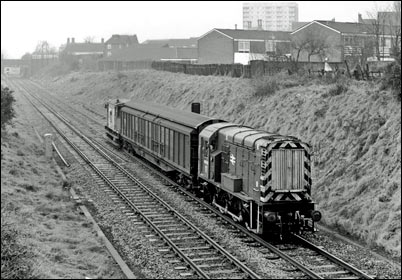
Three duties survived at Bescot right until the end of Speedlink. By the late 1980s the Storage Sidings duty had gone, the disappearance of the last non-Speedlink traffic in the mid-80s meant that the air-braked stuff could be handled in the down Sorting Sidings. The Storage Sidings pilot effectively became a full-time job in the upside, shunting engineers traffic. This left two duties on the downside for Speedlink traffic and any other bits-and-pieces.
Bescot's allocation was bolstered in 1987 when 08517 and 08759 arrived, taking the fleet size back up to ten. It was around this time that the Bloxwich and Wednesbury trip duty became a Class 08 job.
Although freight traffic was relatively stable in the late 1980s a significant change occurred in late 1988. This wasn't a reflection of traffic changes, but an organisational switch-around. It involved the re-allocation of the Birmingham-area shunt locos and their duties to Bescot, and was effectively a reprise of what happened twenty years earlier when Bescot had inherited the duties and locos from several neighbouring steam sheds.
There had already been a shake-up of Birmingham area shunt locos in 1983, in essence Saltley's locos and duties being transferred to Tyseley in June of that year. However a purge of vacuum-braked locos meant that it was a much-changed Tyseley fleet that was transferred en-masse to Bescot in November 1988. This left Bescot with the complete shunt loco allocation for the whole of the West Midlands conurbation...
| Shed | Bescot's shunt loco allocation in November 1988 | Total |
|---|---|---|
| From Tyseley | 08535 08601 08604 08610 08616 08692 08805 08893 08920 08928 | 10 |
| Existing allocation | 08466 08517 08603 08672 08700 08759 08765 08832 08841 08901 | 10 |
| Total number of locos: 20 | ||
The next raft of changes commenced in 1991, when the Speedlink network closed. This saw a major change in the character of Bescot Yard, and manifested as a big bang rather than a gradual decline. Some Speedlink trains had been withdrawn in the years preceding final closure, but many ended on the final day. The effect was very visible. In the Speedlink era a visit to Bescot in the late afternoon or early evening would - as was the case in earlier years - see much activity. Not just trains arriving and departing, but also wagons being shunted, engines being fuelled and prepared, and moving on, off and around the depot. Supporting all this would be staff; drivers, guards and shunters moving around by foot and very visible to the casual observer. In short the place had a buzz of activity about it, even when no trains were moving.
All this changed overnight when Speedlink finished. After that the yard was dead in the evenings, not just devoid of trains and shunting activity, but also the associated human activity. What remained were block trains and engineers traffic. The former ran around the clock, so what was left followed no particular pattern and was thinly spread across the whole day. Many of the regular engineers trains were daytime jobs, inbound ballast, outbound spoil, trips to places like Washwood Heath to collect concrete sleepers, and most of the remaining yard-to-yard departmental trains. The effect was to make Bescot busier in the daytime than during the evening and night - a reversal of the long established pattern for freight traffic. It was the end of Bescot as a serious marshalling yard.
Despite the loss of Speedlink the three year period between late 1988 and late 1991 saw Bescot's shunter allocation increase substantially. 08746 arrived in July 1989, taking the allocation up to 21 at the turn of the decade. Five more08428 08448 08537 08543 08924 arrived in 1990, and these were followed by yet another three08734 08751 08878 in April 1991. The only departure in this period was 08692, which left in June 1990, the same month that 08841 was withdrawn. Eight arrivals and only two losses produced a net increase of six locos, which took the allocation up to twenty-six active locos at the end of 1991. In retrospect this influx of locos is a bit puzzling, and was unjustified by any increase in work. Perhaps these were effects of sectorisation, but whatever the cause the resulting over-provision would be rectified in the years after 1991.
Although sectorisation had begun by this stage, the sectors to which locos were allocated still mapped to depot allocations, which therefore remained meaningful...
| Bescot's shunt loco allocation in December 1991 (MSNB pool) |
|---|
| 08428 08448 08466 08517 08535 08543 08601 08603 08604 08610 08616 08672 08700 08734 08746 08751 08759 08765 08805 08832 08878 08893 08901
08920 08924 08928 08537 (stored unserviceable) |
| Total number of locos: 27 (26 serviceable) |
This was the second high-point in Bescot's shunt loco allocation, albeit reaching only half the number of locos allocated at the first high-point in 1967. In both cases the allocation had been significantly bolstered by the import of locos, and the associated duties, from neighbouring sheds - in effect a consolidation of resources against a background of steadily declining work. This would happen for a third and last time in 1995.
The early 1990s - post-Speedlink and pre-privatisation
By my reckoning there were twelve shunt duties remaining in late 1991, the Bescot Down Hump job having gone around the time that Speedlink ended that year. These were all that was left of both Bescot and Tyseley's jobs at that point.
The remaining job at Wednesbury went in 1992, the steel terminal closing late that year. Another loss in late 1992 was the Kings Norton pilot - a temporary job connected with the Cross-City electrification project - which seems to have ended a few months before the project was finished. Also in late 1992 the Oxley night pilot duty was absorbed by the loco which worked at Wolverhampton Steel Terminal during the day. These changes reduced the number of shunt duties to nine.
Around October 1993 the New St pilot duty was abolished, and the Duddeston pilot no longer worked New St at nights. This further reduced the number of jobs to eight
Given these early 1990s job losses, together with the significant over-provision at the start of the decade, it should have been no surprise that the allocation was once again decimated during the early 1990s. In fact no fewer than twenty of the twenty-six locos allocated at the end of 1991 went during the next three years...
| Year | Locos departing/stored/withdrawn | Total |
|---|---|---|
| 1992 | 08466 08517 08604 08759 08832 08924 (transferred away) 08537 08672 (withdrawn) | 8 |
| 1993 | 08603 08700 08878 (hired out for use on Channel Tunnel work, never to return) 08901 (stored) 08928 (transferred away) | 5 |
| 1994 | 08535 08616 08751 08805 (transferred away) 08448 08610 08893 (stored) | 7 |
| Total number of locos: 20 | ||
The were only three arrivals08623 08914 09104 in this period, all in March 1994, resulting in a net loss of seventeen locos. The upshot of all this was a reduction in the Bescot allocation from twenty-seven locos to just ten, a scenario reminiscent of what happened at the turn of the 1980s.
One significant event in this period was the arrival of 09104 in March 1994, the first Class 09 to be allocated to Bescot. It was one of the then newly-converted Class 09s rather than a bona-fide ex-Southern Region loco, although one of those would come four years later. 09104 had been converted from 08749 in late 1992, and was a Toton loco before its transfer to Bescot.
In April 1994 Railtrack took over control of the infrastructure, and three separate companies were created from the trainload freight business as a prelude to privatisation of freight operations. As part of this geographically-based carve-up Bescot became part of the Transrail empire. A number of the early 1994 transfers were clearly related to this organisational change. Notable changes were the loss of 08616 and 08805 to Tyseley in March, this passenger depot now being completely divorced from the freight railway. As a result the Tyseley shunt duty was no longer a Bescot job, and was now booked for a loco from the HGSS (Central Trains/Tyseley Class 08) pool, although it was still included in the May 1994 Trainload Freight trip notice.
The transfers of 08623 and 08914 in March 1994 were related to the acquisition of the shunt duties at Burton and Rugby, from Toton and Bletchley respectively. 08623 and 08914 were the locos at these two locations when the transfers occurred, and they were effectively paper re-allocations in the first instance. Both locos did eventually appear at Bescot though.
One consequence of the pre-privatisation carve-up was a change to the loco-allocation pools, which now reflected the owning company rather than the owning sector. Bescot's shunt locos became part of an LBBS pool, the "L" prefix indicating Transrail, and "BS" obviously reflecting the shed code. The allocation when Transrail came into being was as follows...
| Bescot's shunt loco allocation in April 1994 (LBBS pool) |
|---|
| 08428 08543 08601 08610 08623 08734 08746 08765 08914 08920 09104 08448 08893 (stored) |
| Total number of locos: 13 (11 serviceable) |
The third and last bulk import of locos occurred in 1995, when Bescot gained most of Bletchley's locos. The three Wolverton Works pilots had been acquired by the works in March 1994, again a result of the split between passenger and freight operations. And Bescot had already gained the Rugby duty, together with 08914, from Bletchley that same year. The residual Bletchley allocation, and their duties, was transferred to Bescot the following year...
| Shed | Bescot's shunt loco allocation in November 1995 | Total |
|---|---|---|
| From Bletchley | 08567 08683 (08/95) 08519 08625 08628 08807 08927 (11/95) | 7 |
| Existing allocation | 08428 08543 08601 08623 08734 08746 08765 08914 08920 09104 08448 08610 08893 (stored) | 13 |
| Total number of locos: 20 (16 serviceable) | ||
Although 08519 was transferred from Bletchley in November 1995 it didn't physically arrive at Bescot until May 1996, at which point it was immediately withdrawn.
The late 1990s - privatisation and EWS
The last of the big organisational changes around privatisation came in February 1996. At this point the three trainload freight companies, created as precursors to privatisation, were sold en-bloc and became EWS (English, Welsh and Scottish Railways). This effectively reversed the split made in 1994, and as a result Bescot became an EWS depot.
At this point there were still duties at Bescot Yard, Wolverhampton Steel Terminal, Oxley CS, Northampton, Rugby, Bletchley, Burton WRD, Washwood Heath, and Bordesley. The creation of a "Virtual Quarry" precipitated a third shunt duty in Bescot Yard during the 1990s. Although new duties were almost unknown by this stage another one materialised when ABP opened a container terminal at Hams Hall in 1997. On the flipside Silverlink acquired their own pilot loco for use at Bletchley in the late 90s.
As for locos, there were plenty of comings-and-goings during the latter half of the 1990s...
| Year | Loco transfers | Net change |
|---|---|---|
| 1996 | Withdrawn/stored: 08428 08519 08734 | -3 |
| 1997 | Transferred-in: 08542 08905 08909 Withdrawn/stored: 08625 08746 08807 08914 | -1 |
| 1998 | Transferred-in: 08535 08580 08698 08884 08888 08946 09021 Transferred-out: 08601 09104 Withdrawn/stored: 08610 08927 | +3 |
| 1999 | Transferred-in: 08397 08695 08802 08866 08907 08939 Withdrawn/stored: 08628 08909 | +4 |
| 2000 | Transferred-in: 08418 08683 09011 09103 Withdrawn/stored: 08535 08542 | +2 |
| Total number of gains: 20 Total number of losses: 15 Net change: +5 | ||
What's noticeable here is how many of the losses were locos going into store rather than being transferred away. Indeed even the two outbound transfers would end up out of traffic within a few months. This suggests a period when allocation changes were being dictated primarily by the mechanical state of the locos. Serviceable locos being shuffled around to replace those in trouble, rather than the failed locos being repaired. This sort of thing had been going on since the 1960s, made possible by declining demand, but it seems to have been especially prevalent during this period.
Of course it would only have been possible if the fleet inherited by EWS was generous for the surviving duties, and even then it would only be possible for a finite period of time. Eventually the number of serviceable locos would diminish to a point at which there were no longer enough of them, which might explain why some of the EWS shunters stored during the late 1990s did subsequently make a comeback.
In addition to these changes the three stored locos08448 08610 08893 from 1995 all left during this period. This resulted in an overall increase of two locos during the EWS tenure from 1996 to March 2001. The allocation grew from 20 to 22, but only five locos stayed for the whole five year period.
The 21st century, and final decline
Bescot lost its complete diesel shunter allocation in March 2001, at this point the remaining shunt locos were formally transferred to other depots. As with the earlier incoming bulk transfers this was primarily an administrative re-organisation rather than a reflection of changed duties on the ground. The locos involved were as follows...
| To depot | Bescot's final shunt loco allocation, disbanded in March 2001 | Total |
|---|---|---|
| Toton | 08418 08543 08567 08580 08623 08683 08695 08698 08765 08884 08888 08905 08920 08939 09021 09103 | 16 |
| Allerton | 08397 08866 08907 08946 | 4 |
| Canton | 08802 09011 | 2 |
| Total number of locos: 22 | ||
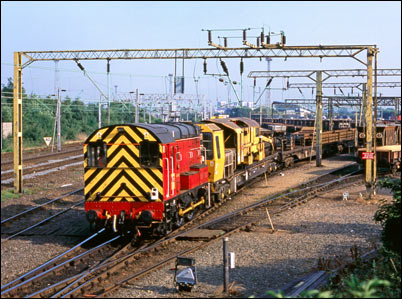
To the best of my knowledge neither 08397 and 08866 ever appeared at Bescot while allocated there. They'd both been transferred in from Crewe in August 1999, and both spent some time at Dee Marsh while allocated to Bescot. They went to Allerton in March 2001.
The locos that went to Toton subsequently became part of a WSMD pool which provided shunt locos for duties all around the Midlands. This included the remaining duties inherited from Bescot, plus jobs in the East Midlands such as Toton, Ketton and Peterborough.
At Bescot itself there was still a steady turnover of locos, much as there had been during the late 1990s. The only difference being that the incoming locos were no longer allocated to Bescot, but simply out-stationed locos from the general pool. Although the locos involved weren't formally allocated to Bescot shunt locos still visited the depot for maintenance, with local moves from places like Wolverhampton Steel Terminal and Oxley still undertaken by rail. The post-2001 comings-and-goings are listed on the allocations page where known. They're shown in yellow.
Meantime shunt duties continued to decline, and in March 2004 the Virtual Quarry pilot ceased to be a Class 08/09 duty. For a while the job was worked by a mainline loco, before being absorbed into the upside pilot duty. This reduced the number of shunter duties in the yard down to two again, one at the south end of the upside and the other at the north end of the downside.
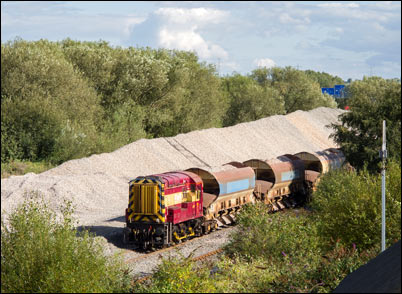
In 2007 EWS was sold to Deutsche Bahn, although it wasn't re-branded as "DB Schenker" until 2009.
It was around this time that the last of the historic Bescot shunt duties faded away. The Wolverhampton Steel Terminal job finished around the end of 2008Last pilot believed to have been 08714, train locos doing the shunt duties thereafter. The Oxley duty ceased to be an EWS hire-in circa April/May 200708653 replaced by 08790, Alstom using one of their own locos from that point forward.
Over in Birmingham the Washwood Heath yard duty finished in the autumn of 2008Last pilot believed to have been 09014, and the yard closed shortly afterwards. The nearby RMC/Cemex duty ceased to be an EWS hire08865 replaced by 08331 circa October/November 2010. From that point they used a loco from RT Rail instead. Hams Hall lasted until May 201308623 replaced by 08873, ABP subsequently hiring from the Hunslet Engine Company rather than DBS.
From September 2009 the Bescot downside pilot duty was abolished, and the shunters cabin at the north end of the yard closed. The last remnants of the Enterprise network had pretty much disappeared by that stage, the Bloxwich trip having ended in 2006 and the Birch Coppice traffic going at the end of 2007.
After the north end job was abolished only one shunt duty remained in Bescot Yard. This was primarily engaged in dealing with engineers traffic on the upside. By this stage much of the work involved moving complete wagon sets around rather than shunting individual wagons or making up engineers trains, although the latter still happened of course. A disposal facility for spoil had been established at the south end of the yard, and wagons would need to be berthed there for unloading. Wagons also needed to be berthed in the ballast siding for loading. The pilot loco would also make occasional visits to the downside to shunt wagons there.
The endgame: 2013-2017
During the late summer of 2013 it was sometimes possible to see two Class 08s in use08907 08623 at Bescot. As well as the regular upside pilot a second loco would also be occasionally used to shunt wagons in the downside yards. Another development in 2013 was the closure of the shunters cabin at the south end of the yard. Thereafter the upside pilot loco normally shunted the engineer's sidings from the other end, and when not in use would be parked near the traincrew offices.
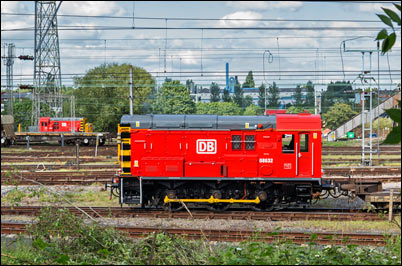
The autumn of 2013 also produced a surprising development when Bescot depot painted 08907 into DBS livery, the first shunt loco anywhere in the country to receive this treatment.
Having dealt with 08907 in October another one, 08623, got the same repaint during November and December. The painting of 08623 in particular was done in "instalments", the loco appearing out of the shed at various points mid-repaint to do a little work around the depot or yard. In March 2014 08623 left, to be replaced by 08632. The new arrival duly acquired DBS livery in May 2014, but no more followed after that. Elsewhere 09106 was done at Warrington Arpley in December 2013, but only these four received DBS livery for reasons that would soon become evident. Somewhat later, in January 2016, Springs Branch painted 08605 into DBS red, but the writing was already on the wall by then.
In September 2014 DB Schenker decided to see if they could dispense with their remaining shunt locos completely. In most locations, including Bescot, mainline locos took over the small number of surviving shunter duties. The upside pilot was often a Class 60 for the first year or so, but eventually these disappeared and it became a solid Class 66 job.
So from autumn 2014 onwards there was no longer a Class 08 duty in the yard, and for Bescot the diesel shunter era was nearly at an end. There were still serviceable shunt locos hanging around the depot though, and these would occasionally be used as depot pilot. By now most of the depot's work was wagon maintenance, so there was an occasional requirement to position wagons. However Class 66s were also used on this task when available, so any residual Class 08 activity was very sporadic.
In March 2016 DB Schenker was rebranded as DB Cargo, and in September 2016 the company finally decided to dispose of their remaining shunt locos, even though a few were still in active use. At this stage there were four Class 08s at Bescot. Fresh off its repaint 08632 had left in June 2014, leaving just 08907 at Bescot. 08623 returned to Bescot in December 2015, but had been out-of-use for most of 2016. Early August 2016 had seen 08703 arrive for an exam, and it was followed about a week later by 08752, also for an exam. A few weeks later these exams were finished so there were three serviceable shunters present, plus the unserviceable one, when the remaining DBC shunt locos were advertised for sale in September. While the tender process was underway all three of the serviceable shunters at Bescot were occasionally used around the depot.
The tender process concluded in November 2016, with all four of the Bescot locos amongst those sold. Despite this the three serviceable locos continued in occasional use around the depot until they were collected by their new owners, something that continued right into January 2017. The eventual departure details were as follows...
| The final diesel shunters of the DBC-era at Bescot | |||
|---|---|---|---|
| Loco | New owner | Departed | Destination |
| 08907 | Great Central Railway, Loughborough | 28/11/2016 | Quorn |
| 08752 | Railway Support Services (RSS) | 09/01/2017 | Derby Litchurch Lane |
| 08703 | Railway Support Services (RSS) | 19/01/2017 | Wigan Springs Branch |
| 08623 | HNRC | 31/08/2017 | Hope Cement Works |
08907 was acquired for preservation. However 08703 and 08752 were bought for commercial use and went directly to their next assignment, without being painted into the smart dark grey RSS livery. Ironically 08703 was replacing a sold DBC shunt loco at Springs Branch, that job effectively being outsourced rather than replaced by a mainline loco. It wasn't the only location that this happened, the Axiom wagon works at Stoke also became an RSS hire at this point.
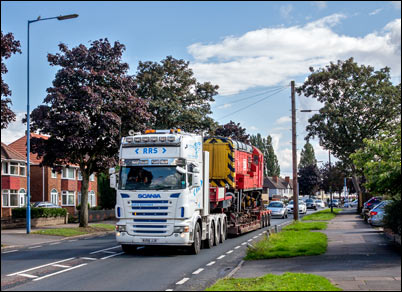
08703 had the privilege of being the last serviceable shunt loco at Bescot. Its last movement may have been on Tuesday 17th January 2017, when it was driven under its own power to a spot near the staff portakabins at around 14:00. It was loaded onto a lorry for departure early on Thursday 19th.
That left just 08623. Missing its coupling rods this loco festered on the depot into the late summer of 2017, its new owner seemingly in no rush to collect it. It finally departed on the afternoon of Thursday 31st August, the lorry leaving the depot at 15:12.
Postscript: 2019
In early 2019 it emerged that GBRf had won the contract to operate the Network Rail LDC (Local Distribution Centre) at Bescot for CP6, i.e. the period April 2019 to March 2024.
This raised the possibility that unlike DBC, who used a mainline locomotive to shunt the yard, GBRf might elect to use a shunting loco as they already did at Whitemoor.
A new era: 2019 and beyond
And so it came to pass. GBRf had won the LDC arrangements for both Eastleigh and Bescot, with effect from 1st April 2019. 08670 and D4157 (08927) were delivered to Bescot on the evening of Thursday 28th March 2019. Both locos are owned by RSS.
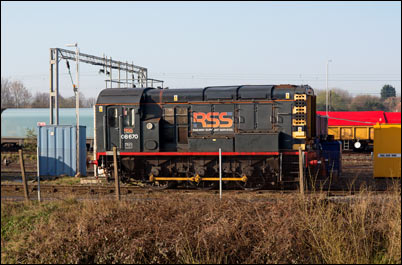
Unusually, but perhaps understandably, the Bescot ones were delivered direct to the upside via Sandy Lane, rather than via the (DBC) depot entrance as had been the normal route for locos leaving or arriving by road. This arrangement has persisted, although it's a tight squeeze for the lorries to get over the single lane bridge that crosses the running lines.
573 days had elapsed between the departure of 08623 in August 2017 and the arrival of 08670 and 08927 in March 2019. A period of just under 19 months in which there were no shunt locos at Bescot. And it had been over two years since the last serviceable Class 08 left in January 2017.
GBRf operations commenced on Monday 1st April 2019. D4157 took up shunting duties for the first few days, with 08670 receiving mechanical attention on Wednesday 3rd and Thursday 4th April. 08670 started to see use from around Wednesday 10th April, and although only one loco was generally in use at any given time, both were active from mid-April onwards.
As expected loco swaps under the new regime are infrequent, and the locos used by GBRf are summarised in the table below. All were in RSS's dark grey livery unless noted otherwise...
| Start date | Locos | Comment |
|---|---|---|
| 01/04/2019 | 08670 08927 | 927 was in BR green and numbered D4157. |
| Late October 2019 | 08632 08670 | 632 was barely used during this spell at Bescot. |
| Early July 2020 | 08670 08927 | 670 briefly returned to Wishaw in mid-May 2022. It wasn't replaced, and was back at Bescot within a week or so. 927 was still in BR green and numbered D4157. It was rarely used for at least the last 18 months of this two year stay. |
| 25/07/2022 | 08670 08825 | 670 again went missing during the w/c 9th January 2023. It re-appeared on or about Thursday 19th. 825 was in NSE livery, hired-in by RSS from the Chinnor & Princes Risborough Railway. |
| 18/04/2023 | 08460 08670 | |
| 05/09/2024 | 08460 08853 | 853 had only recently been acquired by RSS from Wabtec at Doncaster. |
| 02/09/2025 | 08460 08703 |
In September 2024 GBRf had just started to use Class 18 battery electric shunt locos at Whitemoor and Eastleigh, and there were expectations that one of these would probably turn up at Bescot too. But in the event it was 08853 that replaced 08670 on Thursday 5th September 2024.
Of the seven different 08s provided by RSS during GBRf's 6½ year operation of the yard only 08853 hadn't previously visited Bescot (at least not since the mid-1970s).
Notes:
In most cases the dates given for transfers are the official ones, as reported by various sources. In practise these didn't always correspond to the dates that locos physically moved, and in a few cases reflected events that never happened on the ground. These are usually referred to as "paper transfers", and are indicated where known.
Many thanks to Ian Pell, Mike Hollick, Dave H and Shunterspot for help with this page.
Corrections, clarifications and additional information are all welcome.